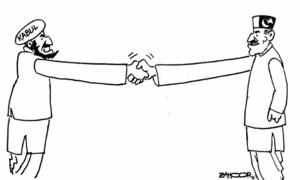No matter how horrendous the atrocities or massacres, humans have the stark ability to rationalise their actions using a mixture of pseudoscience and ideological narratives. It is only decades or centuries later, when the annals of history are reopened, that those ‘rationalised’ actions are questioned. Because of poor records, historians are not always lucky enough to have access to primary sources or details of events. At times there are just a few artefacts — broken pieces — from which the historian has to reconstruct the past.
As the title of his book suggests, Kim A. Wagner begins his research on this marvellous piece of subaltern prosopography with the skull of Alum Bheg, hawaldaar [sergeant] of the 46th Bengal Native Infantry (BNI) stationed at Sialkot in service of the British East India Company (EIC). In 1963, this skull was discovered in Kent, England, in the unlikeliest of places — a pub. With it was a brief note vilifying Bheg as a principle ‘mutineer’ during the ‘revolt’ of 1857 and ‘murderer of Europeans’. In 2014, the skull came in the possession of the author and, as he writes, “I felt an immediate urge to recover something of the life story of the man who once looked out through those eye-sockets.”
Wagner details that though he struggled to find historical references for Bheg, he managed to unearth numerous accounts of Europeans working in some capacity with Bheg and the 46th BNI. During the 18th and 19th centuries, by utilising existing networks of patronage, the EIC recruited high caste peasant regiments directly from the zamindaars [landholders] of Awadh and Bihar in north India. In return, the EIC promised a decent salary and the prestige of serving as a soldier. As such, the sepoy [infantry] army was a homogenous unit composed largely of high caste Hindus, while the sowar [cavalry] regiments were often Muslims. The revolt at Sialkot — or broadly, in India — didn’t happen overnight; it occurred because of a number of policy measures taken by the EIC that resulted in the alienation of sepoy regiments.
A superbly researched, fresh perspective on the 1857 war of independence
Even before the Battle of Plassey in 1757, the EIC’s sepoys had served with unflinching loyalty. They had died, guarded and conquered India for the British. So much so that the high castes, who were forbidden to leave India, even fought in the First Anglo-Afghan War of 1839-42. All they asked in return was respect for their traditions. Instead, the sepoys were commanded to use new Lee-Enfield rifles which required them to bite cartridges covered with either pig or cow fat — an act synonymous with blasphemy for Muslims and Hindus alike. The Bengal Sati Regulation of 1829, wider caste recruitment of sepoys in 1834, increasing missionary activities, the General Service Enlistment Act of 1856 to serve overseas when commanded, the annexation of Awadh in 1856 and other British actions were viewed by the sepoys as deliberate British efforts to pollute their religion, history, tradition and castes.
Moreover, it didn’t help that many British officers and missionaries had racial and fanatical attitudes. Thomas Hunter, a Scottish missionary in Sialkot, writes (the book doesn’t specify where, but seemingly it is in a letter), “There are such obstacles to the preaching and teaching of Christ crucified as the people of Scotland cannot have much idea of. Verily ‘Satan’s seat’ appears to be in this place. Sialkot is a stronghold in which his followers stand garrisoned.” All of this provoked a desire for resistance amongst the Indian army.
In 1857, when the sepoys at Meerut refused to use the cartridges, they were flogged and sentenced to 10 years of hard labour. Wagner writes, “the prisoners, seeing their hands and feet manacled, looked at their medals and wept … Then the rest of the troops felt they would be complied to bite the cartridges, or they would suffer a similar fate.” On May 10, 1857, the ‘revolt’ began and quickly spread to major cities of north India. Sialkot was far away from this turmoil. Bheg and his 46th BNI were watching the events unfold, but they showed no sign of rebellion. To punish the ‘mutineers’, the British regiments, along with the 35th BNI and half of the 9th Bengal Light Cavalry (BLC) left Sialkot, leaving behind the 46th BNI and the rest of the 9th BLC.
Fearing further mutiny, the British started to disarm the Indian army in Punjab. When the 35th BNI was disarmed in Lahore, some of its sepoys went to Sialkot to warn Bheg’s regiment that the British were coming to disarm them next, and if they showed any resistance, harsh punishment would follow. The 46th BNI was torn; if the British could not trust them, then what option did they have apart from mutiny?
The attack on the Europeans was targeted; the night before July 9, the sowars of the 9th BLC stationed at Sialkot had made a list of officers against whom they held a vendetta. In addition, the next day they released prisoners who incited pillaging of the cantonment, markets and buildings that symbolised colonial rule. During the rioting and confusion that followed and despite the fact that the 46th BNI had chosen to serve the Mughal emperor at Delhi, Bheg and his men stood guard over the homes of the British officers and families. Wagner writes, “Although the power dynamics of the colonial state were rapidly collapsing, some bonds evidently remained intact.”
Wagner continues, “Truth is that the outbreak at Sialkot was a highly contingent and confused event, and one that in many ways differed from places [such as] Meerut, Delhi and elsewhere. At Sialkot there was … no lynching of isolated sahibs, no sexual attack on memsahibs and no mutilation of their corpses. Though many opportunities presented [themselves], sepoys did not take part in any such thing.”
On the road to Delhi, the 46th BNI and 9th BLC were intercepted by the decorated 52nd Oxfordshire Regiment of Foot Light Infantry — which had fought at the Battle of Waterloo against Napoleon Bonaparte — supported by Sikh levies and Pakhtun riders. The brave sepoys made their last stand on the lonely island of Trimmu Ghat in the river Ravi. A contemporary observer noted, “It was butchery, no doubt, and the 46th Native Infantry, who had protected their officers, hardly deserved annihilation, but the holocaust was necessary.” Of the 1200, few — including Bheg — survived and fled to Kashmir. Inevitably, they were caught.
Being a ranking officer, Bheg was thought of as a ringleader. After a court martial on July 8, 1858, he was condemned to be blown by cannon — the ultimate symbol of power, colonial retribution and reestablishment of British supremacy. What remained of the body could neither be buried nor burned — the fear of being denied funeral rites petrified both Muslims and Hindus. Wagner then details numerous instances where similar, if not worse, forms of summary executions of the sepoys were carried out and skulls and various body parts were collected by the British officers as trophies.

Learning from the EIC’s error of interfering in local culture and practices, the British Crown abolished the EIC and enforced a strict policy of non-interference. Moreover, the British explicitly denied the reports of rape and atrocities ostensibly carried out by sepoys. Wagner writes, “once the dust had settled, and peace supposedly restored, they [reports] proved merely to be painful and disruptive.”
In the last chapter, Wagner argues that there exist no mechanisms through which this skull and other remains currently in the British Museum can be returned to India. He hopes to increase awareness with this book. Finally, he proposes that, “I think the peaceful site of the Battle of Trimmu Ghat, on the island in the Ravi River, which today marks the border between India and Pakistan, would be a fitting place to bury him. Ultimately, that is not for me to decide, but whatever happens, the final chapter of Alum Bheg’s story has yet to be written.”
Here I am not being critical of Wagner’s research, but it is at times frustrating that there are so few primary accounts of the sepoys themselves — not many probably exist. But the absence of these narratives results in a black hole that can only be circumvented by relying on the accounts of the Europeans. The only problem is that it is some spaces, interpolation of what the sepoys went through — or subaltern history — and might be subject to imagination. However, despite the many challenges, Wagner has been able to navigate through these treacherous waters and provide us a different perspective.
With this book Wagner casts off the crimes — mutiny and murder — for which the men of the 46th BNI were massacred. And by doing so, Wagner does something truly magical: nearly 160 years after Bheg’s brutal execution, Wagner returns him and his comrades their rightful and due honour. These were loyal men who chose to ‘rebel’ only because the British didn’t have faith in them. Even then, they safeguarded the families of the very officers who later carried out their execution. What a paradox!g
The reviewer is a pre-Partition South Asian history enthusiast, currently pursuing graduate studies at Maxwell School, Syracuse University
The Skull of Alum Bheg: The Life and Death
of a Rebel of 1857
By Kim A. Wagner
Hurst and Co., UK
ISBN: 978-1849048705
256pp.
Published in Dawn, Books & Authors, April 29th, 2018














































